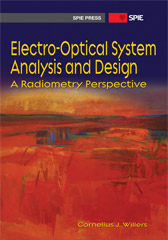The purpose of computing is insight, not numbers.
-- Richard Hamming
-
pyradi is no longer supported on PyPI, please install directly from this repository (details below).
-
Setting up and getting to know pyradi requires some grit on your part. The toolkit is offered as an engineering tool to other engineers; it is not intended to be used casually by uninformed persons. Most of the documentation is written up in the code itself. The additional documentation is relatively sparse.
-
Some of the tools in pyradi are quite powerful and require careful study and insight to use correctly. Do not take shortcuts!
The PyRadi toolkit is a Python toolkit to perform optical and infrared computational radiometry (flux flow) calculations.
The toolkit is an extendable, integrated and coherent collection of basic functions, code modules, documentation, example templates, unit tests and resources, that can be applied towards diverse calculations in the electro-optics domain. The toolkit covers
-
Models of physical radiators (e.g., Planck's Law) and conversion between values expressed in different units.
-
Mathematical operations for radiometry (e.g., spectral integrals, spatial integrals, spectral convolution)
-
Data manipulation (e.g., file input/output, interpolation, spectral quantity conversions, reading Flir Inc PTW files)
-
Detector modelling from physical parameters: including single element detectors and staring arrays
-
3-D noise analysis of image sequences
-
Modtran tape7 read functions
-
Graphical visualization(2-D and 3-D graphs) in compact format, including cartesian, polar, image and mesh plots.
-
Spectral variables are expressed in Numpy arrays to ease spectral operations and integrals.
-
A powerful staring array sensor that accounts for various noise sources and nonlinearities.
The individual scripts in the toolkit is supported by examples, test cases and documentation. These examples are included at the end of each script in the __main__ section. If you just run the script, the code will be executed and results will be available in graphs or text files.
The most recent version of pyradi was last tested in July 2019 using Python 3.7. Python 2.7 is no longer supported (the code may still work, but it is not actively supported).
Please see this link for installation procedures. It should take you to the online nbviewer to open a notebook (00-Installing-Python-pyradi.ipynb) in the companion repository https://github.com/NelisW/ComputationalRadiometry.
To use pyradi you would have to know Python and Numpy. Getting acquainted with a new tool or computer language takes time and practice. Invest your precious time in learning Python and its modules, you will not be disappointed!
There are many free
books,
classes,
getting started blogs websites and tutorials
videos,
more videos and
conferences. Material for Numpy is less bountiful, but the
numpy reference and StackOverflow are good sources.
Just google some variation of 'learning python' and make your choice.
A comprehensive list of training material is given here
This project has Production status. Current content is tested, stable and usable. The scope of the pyradi is continually growing as new functionality and examples are added.
The development is ongoing as and when new needs arise. We are open for feature requests as well.
- Module documentation is available in
- HTML and PDF.
- A number of IPython notebooks demonstrate pyradi use. Head on over to Computational Radiometry to download the notebooks. If you are not using the IPython notebook, the are also HTML renderings in the online notebook viewer.
- At the end of each of the pyradi files, in the main section, you will find test and example code demonstrating the use of that specific file. Some day, these will find their way into a tutorial, but for now, please study the example code.
- "Pyradi: an open-source toolkit for infrared calculation and data processing", SPIE Proceedings Vol 8543, Security+Defence 2012, Technologies for Optical Countermeasures, Edinburgh, 24-27 September, C.J. Willers, M. S. Willers, R.A.T. Santos, P.J. van der Merwe, J.J. Calitz, A de Waal and A.E. Mudau.
- "Pyradi radiometry toolkit", C.J. Willers, M. S. Willers, R.A.T. Santos, P.J. van der Merwe, J.J. Calitz, A de Waal and A.E. Mudau, SPIE Newsroom, DOI:10.1117/2.1201211.004568, 2012.
- Electro-Optical System Analysis and Design: A Radiometry Perspective provides detailed examples of pyradi use. The 528-page book provides detailed coverage of radiometry and infrared system analysis and design. It uses pyradi in the extensively documented computational examples. Electro-Optical System Analysis and Design: A Radiometry Perspective, Cornelius J. Willers, ISBN 9780819495693, SPIE Monograph Volume PM236, SPIE Press, 2013. The book is available from SPIE and Amazon.
Note that pyradi is no longer available on PyPi.
You can download the very latest version of pyradi from the pyradi repository on GitHub.
Note that the git checkout only installs pyradi and not any of its dependency packages matplotlib, numpy, scipy or scikit-image.
If you install the Anaconda distribution all the dependency packages should already be present.
In order to keep the size of the pyradi repository smaller, some pyradi information has been moved to separate repositories. If you require to work on regression testing and documentation, check out the tree repositories as follows:
..
+-pyradi [https://github.com/NelisW/pyradi]
+-.git
|-setup.py (this file)
| ...
+-pyradi
+ ... all the pyradi files
+-pyradi-docs [https://github.com/NelisW/pyradi-data] (this is an optional clone)
+-.git
+-_build
+-pyradi-data [https://github.com/NelisW/pyradi-docs] (this is an optional clone)
+-.git
+-regression
+-images
For image segmentation and analysis, please see <http://scikit-image.org/ scikit-image>.
For hyperspectral image processing see <http://spectralpython.sourceforge.net/ Spectral Python>.
The authors gratefully acknowledge the CSIR and Denel Dynamics for support in the development of the code.
You can contact the pyradi community by emailing the repository owner through github or at neliswillers at gmail.

